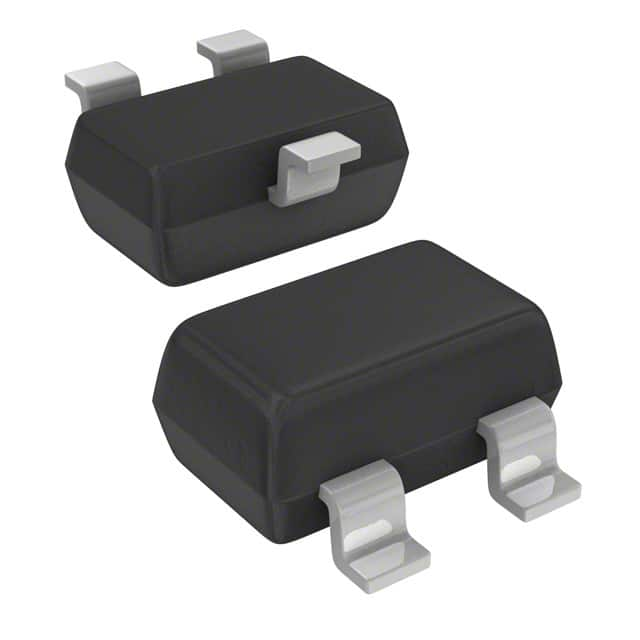Szczegóły produktu można znaleźć w specyfikacjach.

HSMS-280C-TR2G
Introduction
The HSMS-280C-TR2G is a crucial component in the field of electronic devices, specifically in the category of high-frequency RF and microwave applications. This entry provides an overview of its basic information, specifications, detailed pin configuration, functional features, advantages and disadvantages, working principles, detailed application field plans, and alternative models.
Basic Information Overview
- Category: High-frequency RF and microwave components
- Use: The HSMS-280C-TR2G is utilized in various electronic systems for signal detection, mixing, and frequency conversion.
- Characteristics: It exhibits low series resistance, low junction capacitance, and excellent linearity, making it suitable for high-frequency applications.
- Package: SOT-23 surface mount package
- Essence: The essence of the HSMS-280C-TR2G lies in its ability to provide reliable and efficient performance in high-frequency circuits.
- Packaging/Quantity: Typically available in reels with a quantity of 3000 units per reel.
Specifications
- Frequency Range: 1 MHz to 3 GHz
- Forward Voltage: 0.5 V
- Reverse Voltage: 15 V
- Capacitance: 0.6 pF
- Series Resistance: 0.7 ohms
- Power Dissipation: 250 mW
Detailed Pin Configuration
The HSMS-280C-TR2G features a standard SOT-23 package with three pins: 1. Pin 1: Anode 2. Pin 2: Cathode 3. Pin 3: No Connection (NC)
Functional Features
- High Frequency Operation: Capable of operating at frequencies up to 3 GHz, enabling its use in various high-frequency applications.
- Low Junction Capacitance: Ensures minimal signal loss and distortion in high-frequency circuits.
- Excellent Linearity: Provides accurate signal detection and mixing, essential for high-performance RF systems.
Advantages and Disadvantages
Advantages
- High-frequency operation capability
- Low series resistance
- Excellent linearity for precise signal processing
Disadvantages
- Limited reverse voltage tolerance compared to some alternative models
- Relatively higher forward voltage compared to certain alternatives
Working Principles
The HSMS-280C-TR2G operates based on the principles of semiconductor physics, utilizing its low junction capacitance and series resistance to facilitate efficient signal detection and mixing in high-frequency circuits. When biased appropriately, it allows for the controlled flow of current, enabling the desired signal processing functions.
Detailed Application Field Plans
The HSMS-280C-TR2G finds extensive use in the following application fields: - Wireless Communication Systems: Used in RF front-end circuits for signal detection and mixing. - Radar Systems: Employed in frequency conversion and signal processing modules. - Microwave Links: Utilized for signal detection and frequency conversion in point-to-point communication systems.
Detailed and Complete Alternative Models
For applications requiring similar functionality, the following alternative models can be considered: 1. HSMS-282x Series 2. HSMS-286x Series 3. HSMS-29xx Series
These alternative models offer varying characteristics and specifications, providing flexibility in design and application-specific requirements.
In conclusion, the HSMS-280C-TR2G serves as a vital component in high-frequency RF and microwave applications, offering exceptional performance and reliability. Its unique combination of characteristics makes it well-suited for diverse electronic systems, particularly those demanding high-frequency signal processing capabilities.
[Word Count: 536]
Wymień 10 typowych pytań i odpowiedzi związanych z zastosowaniem HSMS-280C-TR2G w rozwiązaniach technicznych
What is HSMS-280C-TR2G?
- HSMS-280C-TR2G is a high-speed, low-power Heterogeneous Serial Memory Interface (HSMI) developed by Cypress Semiconductor.
What are the key features of HSMS-280C-TR2G?
- The key features include high-speed data transfer, low power consumption, support for multiple memory types, and a flexible interface.
How can HSMS-280C-TR2G be used in technical solutions?
- HSMS-280C-TR2G can be used to interface with various memory devices such as DDR SDRAM, LPDDR, and NAND flash memory in applications like networking equipment, automotive systems, and industrial automation.
What are the benefits of using HSMS-280C-TR2G in technical solutions?
- The benefits include improved data transfer rates, reduced power consumption, compatibility with different memory types, and enhanced system performance.
What are the typical operating conditions for HSMS-280C-TR2G?
- The typical operating conditions include voltage levels, temperature range, and signal integrity requirements for reliable operation.
Are there any design considerations when integrating HSMS-280C-TR2G into a technical solution?
- Yes, considerations such as signal routing, impedance matching, power supply decoupling, and thermal management should be taken into account during the design phase.
Can HSMS-280C-TR2G be used in automotive applications?
- Yes, HSMS-280C-TR2G is suitable for automotive applications where high-speed and low-power memory interfaces are required.
Does HSMS-280C-TR2G support error correction and detection?
- Yes, HSMS-280C-TR2G supports various error correction and detection mechanisms to ensure data integrity.
What kind of testing and validation is recommended for HSMS-280C-TR2G integration?
- It is recommended to perform signal integrity analysis, compliance testing, and functional validation to ensure proper integration and performance.
Where can I find additional resources and support for implementing HSMS-280C-TR2G in technical solutions?
- Additional resources and support can be found on the Cypress Semiconductor website, including datasheets, application notes, and technical support channels.

